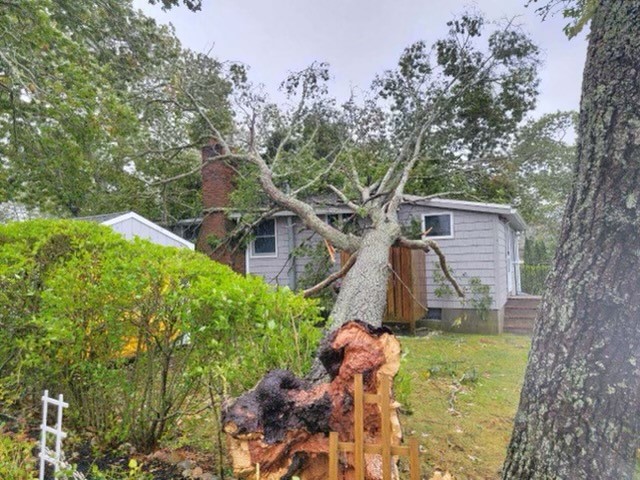-

As a homeowner that has insurance cover, you should know that your insurance also covers tree damage whether you are the owner of the tree or not.
If your tree or that of your neighbor affects any of your insured property, your normal homeowner’s insurance cover should take care of those damages. This applies to trees that are brought down either by storm or lightning.
Also, you should know that you are still insured regardless of who the owner of the tree is–whether it’s yours or that of your neighbor. You are free to file a claim with your insurance firm if a tree falls in your home.
Usually, during a wind, several trees can be removed and transported to different places thus damaging people’s properties. Most insurance companies find it difficult in finding out who the real owners of those trees were. But if the insurance company can locate who the owner of the tree was that destroyed your property, they will collect some funds from the tree owner’s insurance company through a process known as “subrogation”. If your insurance firm can successfully get that done, you would be reimbursed for your deductible.
To avoid tree damage often, it will be good you learn more about tree health and take tree care seriously. Prepare your trees ahead of winter so you don’t have to spend so much money when the storm comes. Poor maintenance of trees is not covered by the homeowners’ insurance policy. So, engage in regular Tree trimming and tree pruning and if you notice anything weird about your tree, notify a tree service company near you to check it out and do what’s is necessary.
As regards being covered for tree removal, if your tree or that of your neighbor, hits any of your insured property, your homeowner’s insurance policy will take care of the cost of removing the tree for up to five hundred to one thousand dollars, based on the kind of policy that was bought and the insurer.
But in a case where the tree that fell didn’t hit an insured property, the insurance company will not cover for debris removal. Certain insurance companies may take care of the cost of getting rid of the felled tree if it is obstructing a ramp that was created for handicaps or a driveway.
Most homeowners’ insurance policies cover damages that were done to shrubs and trees as a result of accidents or disasters such as storms, lightning, fire, theft, explosion, or others. But the coverage for disasters like these is just five percent of the amount of insurance on the property. Also, for shrubs and trees that are nurtured for commercial reasons, they would need a unique business insurance cover to take care of that.
When you are signing up for an insurance policy, ensure you put your expensive trees into consideration. That way, if anything happens to them, they can be properly covered.
How to file a claim with your insurance company
If a violent wind damages your trees or any of your properties, you must file a claim with your insurance company. There are certain procedures your insurance company expects you to follow when something happens to any of the structures in your house. You should read through your insurance policy to know the role you need to play but below are some steps you need to follow to get it done.
- Consult an insurance expert immediately. Find out if your insurance covers the tree damage, how long you have to wait to successfully file a claim if your claim is more than your deductible, how much time it will take to finish the processing of your claim, and if you will need to provide an estimate for the repairs of your claim.
- Contact your insurance company to send the necessary claim forms to you and fill them. After filling them, send them back to your insurance company within the stipulated period.
- Allow the insurance adjuster to inspect the tree damage that was done on your property so they can evaluate how much your insurance company will pay for the damages. Also, you would be interviewed briefly. So, prepare adequately for the adjuster’s visit. Create a list of your properties that were damaged so you won’t forget about any valuable thing.
- Take pictures and videos of the damages that were done on your property. You can also make temporary repairs on your property until the insurance adjuster visits. Don’t dispose of any damaged item until your insurance adjuster inspects your property. Also, keep the receipts of what you spent on the temporary repairs so that you can give the insurance adjuster for reimbursement when he/she visits.
If there are other questions you will want to ask regarding filing for an insurance claim in your state, do well to contact the state department of insurance or ask an insurance expert.
Immediately you and your insurance company reach an agreement regarding the terms of the settlement, your funds would be sent to you.
You must take care of your trees properly so that it doesn’t get damaged. If you don’t take care of your trees properly, wind, snow, or ice can weaken your trees and the branches will gradually start breaking and can cause a nuisance to your properties. Practice tree trimming and tree pruning regularly. Pruning your trees enhances quality airflow and also helps light to easily enter.
Another way of taking care of your trees is by always watering them. Just the same way you as a human should always stay hydrated, your trees should also be hydrated. Keeping your trees hydrated will prevent the branches from breaking off and drying up. When branches get broken, they are exposed to diseases and insect infestation. Practice adding anti-desiccant spray in the water you use in spraying your trees, so that way, your trees are hydrated and protected from pest infestation.
Also, wrapping your tree up during extreme weather conditions is a way of taking care of it. You can contact a tree service company to handle wrapping your trees or you could buy tree wraps and do it yourself. Some tree wraps also help to protect your trees from insect infestation.
Conclusion
A homeowner’s insurance usually covers tree damage whether the tree was that of the insurer or not. It is also important that you take tree health and tree care seriously to prevent them from getting easily damaged by the storm because your insurance company will not take care of poor tree maintenance fees. Also, don’t trivialize tree trimming and tree pruning–you should do it often.
Are Trees Damaging Your Property?
Sometimes one bad tree can damage your entire landscape and even your home. Consult with our trained staff for a free assessment
Available 24/7 for Emergency Service
Did lightning strike? That’s our specialty. One call and we will dispatch our emergency response team to handle all your emergency tree service needs
Hours
Monday: 7:30am - 6:30pm
Tuesday: 7:30am - 6:30pm
Wednesday: 7:30am - 6:30pm
Thursday: 7:30am - 6:30pm
Friday: 7:30am - 6:30pm
Saturday: 7:30am - 6:30pm
Sunday: Closed
We Are Serving Plymouth, MA | Milton, MA | Canton, MA
Copyright © 2022 - Lighting Strikes Tree LLC. All Rights Reserved.

